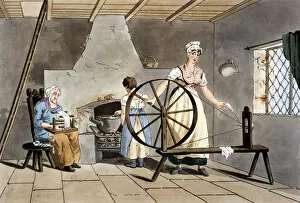George Walker Of Seacroft Collection
"George Walker of Seacroft: Capturing the Essence of 1814" Step back in time to 1814, a year filled with significant moments that shaped history
All Professionally Made to Order for Quick Shipping
"George Walker of Seacroft: Capturing the Essence of 1814" Step back in time to 1814, a year filled with significant moments that shaped history. George Walker of Seacroft, an artist known for his meticulous attention to detail, immortalized this era through his captivating artworks. In "Cloth Dressers, " we witness the skilled hands and precision involved in transforming raw wool into exquisite fabrics. The Blenkinsop steam locomotive at Middleton colliery near Leeds showcases the advancements in transportation that revolutionized industries during this period. The "Thirty-Third Regiment" painting by Robert Havell and Daniel Havell depicts soldiers standing tall, representing their unwavering dedication to duty. Meanwhile, "Three generations of women" portrays the strength and resilience passed down from one generation to another. However, not all aspects were as idyllic. In "Child factory workers, " Robert Havell exposes the harsh reality faced by young laborers during this time. Similarly revealing is "Rape threshing, " shedding light on agricultural practices that were prevalent then. Moving away from industry-focused scenes, George Walker's artwork takes us inside an alum works in Whitby area - a testament to Yorkshire's rich heritage. Additionally, he captures the intricacies of cropping wool after raising its nap – a vital step towards achieving perfection. Walker also delves into societal issues with his piece titled "The Factory Children. " This thought-provoking artwork highlights the need for reform and better working conditions for these young individuals. Leeds' bustling Cloth Hall comes alive within Walker's brushstrokes as merchants eagerly present their wares for sale. A hub of commerce and craftsmanship where dreams are woven into reality. Lastly, we glimpse into rural life with Lowkers - hardworking women who meticulously weed corn fields under the watchful eye of George Walker himself.











